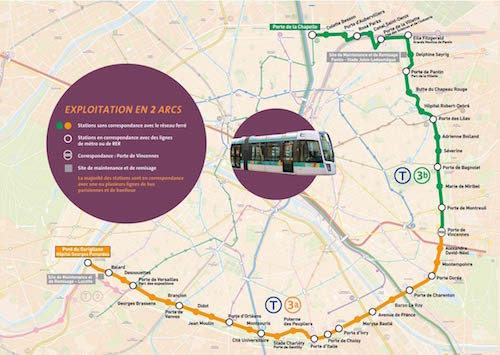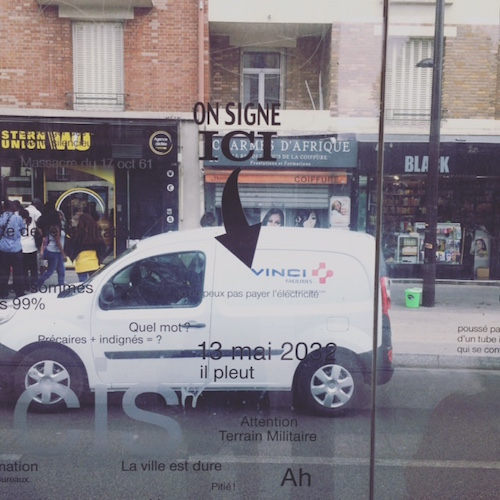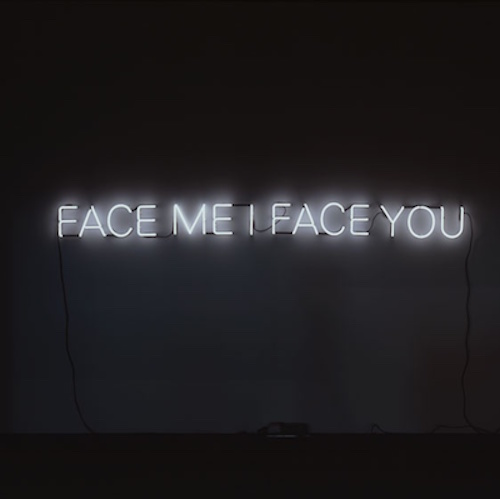
Paris, France
Part 2: On Transparency
In Paris When It’s Naked, Etel Adnan writes: “And then, look at Paris, do it in your imagination if your eyes can’t find it, and see what a solid mass of a city it is, what a fugue in its composition, what an epic story in its stones, what an evanescent spirit in its rain.”
On a warm, clear day in July, I take the Paris Métro Line 1 to almost its eastern end. At Porte de Vincennes, I can transfer to the T3b tramline. In June, at the Poetry International Festival in Rotterdam, French poet Pierre Alferi read two poems, “Traminiscences” and “Parties du paysage” (Part of the Landscape), that he explained were part of a collaborative project with Olivier Cadiot and were displayed on the T3b’s stops. I had read the poems and their English translations before but in a lineated, linear form. The poems he showed at the festival were typographically experimental, concrete. He claimed that because they were etched onto glass, their composition changed depending on the light, the reflections, the cars and people passing behind and before them. Because lines were rendered in different textures and depths, some might disappear entirely when seen at certain angles.
The T3 line nearly circles Paris, demarcating the city’s border with its suburbs. The T3b spans the city’s eastern end, Porte de Vincennes, to its northern one, Porte de la Chapelle. Alferi also suggested that the poems made direct references to both the history and contemporary life along this line.

I’m becoming increasingly interested in site-specific poetry. I like the idea of writing an essay for Harriet structured as a commute, going from tram stop to tram stop. I find these two concrete poems, as he explained them, more interesting than his other verse, “A Defence of Poetry,” which begins with something about garden gnomes. I also unexpectedly find myself on a panel with him, my colleague Jan Baeke, and Kenneth Goldsmith at the festival—a panel called “Kenneth Goldsmith: The Art of Uncreative Writing.” This is Goldsmith’s first public appearance after “The Body of Michael Brown.” I’m deeply critical of conceptual writing, but I disagree with Alferi’s critique. I want to process this experience somehow, but I’m tired of feeding the machine.
- Porte de Vincennes – Porte de Montreuil
At Porte de Vincennes, I’m not really sure what I’m looking for. Are the poems on the tram stops themselves, or are they installed somewhere nearby? Is there a different poem at each tram stop? Is this one of them?

When I get to Porte de Montreuil, my questions about the poems are answered: they are etched onto the glass marking out the tram stop, and all of the poems are there, one next to the other.
Also there are the commuters. They are leaning against the glass walls, looking at their phones, or sitting on benches framed by the Choses Vues (Things Seen), as Alferi and Cadiot’s collaboration is called. As I walk around trying to read and to photograph the poems, I notice that people start looking at me. And of course I am looking at them.

This is at the border with the banlieue. This is a Paris I don’t know, because this is a Paris with no tourists. This is a Paris without clusters of well-dressed Chinese twentysomethings taking photos, carrying shopping bags. This is a Paris without clusters of well-meaningly-dressed American exchange students on their way to the Musée D’Orsay or Ladurée. This is a Paris with clusters of North African women wearing headscarves. This is a Paris that is known as “Little Bamako.” This is a Paris lined with salons and beauty shops called Charmes d’Afrique and Rani Bazar. This is a Paris that is kept at the margins.

Through one of the glass panes I see a line of people, going down the sidewalk, in front of a Western Union. I am unexpectedly emotional, feel something close to despair, by how the “WU” of its logo aligns/rhymes with a “Vu” from Choses Vues. And then another word suddenly materializes (via very, very high-speed broadband?) below this: “reve.”
- Marie de Miribel – Porte de Bagnolet – Séverine
“Did you notice anything interesting about the names of the stops?” Pierre asks the next day, as we have margaritas with my Australian friend Damon Young near République.
—It’s le 14 juillet, and earlier Damon mentioned that we had checked out the bals des pompiers in this very neighborhood the previous night. I squirmed a little, embarrassed. “What’s that from? Do you know how it came about?” Damon continued, and Pierre responded, “Well, do you know Bastille? It’s a national holiday for the charge on Bastille…” I squirmed even more, trying not to laugh.
Later, as Damon and I get onto the subway, Damon suggests that Pierre was so unwilling to engage on the topic of drunk tourists gaping at stripping firemen, that he sublimated the question to be about the French Revolution.—
Séverine, I recall, is a singer. As is Ella Fitzgerald, of course. But why are Ella Fitzgerald and Rosa Parks the two Americans on this list of tram stops? I wonder who Marie de Miribel is, I wonder if she is a medieval writer like Christine de Pizan.
The obvious fact is that they are all women. But that’s not enough for me. I want to ask, “Why these women? Why in these particular places? There must be some kind of reasoning. And why were Ella Fitzgerald and Rosa Parks brought into all this? What are they standing in for, that the French couldn’t fill themselves?”
I’m defensive in a way I don’t understand. I let it go.
- Adrienne Bolland – Porte des Lilas
et pourtant la plupart
des événements qui nous affectent
le plus ne laissent aucune trace physique.
The whole sequence of poems is repeated at each stop. As I keep looking at them, I think I can start to differentiate between Alferi’s and Cadiot’s sections; I begin to notice what seem to be two differing impulses. In “Traminiscences” and “Parties du paysage,” which I knew already to be Alferi’s poems, one can read both anticipation and evasiveness as strategies for openness.

“Traminiscences,” for example, begins with listing types of buildings that were once (at an undisclosed time) in the areas the T3b tramline goes past, and then it lists buildings that are still there. These buildings are not particularly specific: Alferi opts for “warehouses” and “canals” rather than “IT firms,” “Western Unions” or “Rani Bazar.” The tramline covers the entire northwest trajectory of Paris’ suburban border, so imagining that some trace of “warehouses / silos / cement works / canals” will remain evident around one or more of the stops for a while isn’t difficult. Similarly, the list of figures that populate these areas are marked either with a reference to the past, or by a neutral ubiquity masked by the suggestion of descriptiveness: “a boy pulling a cart,” “a young black worker,” “a robust old lady.” In this way, akin to a wily fortuneteller, the poem can anticipate what future readers might observe, or feel that they could have observed, in the poem’s various settings.
Alferi’s lines are often self-reflexive, meditating on how they might be altered, refused or re-visioned once placed on glass panels in the midst of a cityscape. “Rub me out! says the graffiti” in “Parties du paysage,” and it’s immediately evident that the poetry itself is graffiti inscribed onto everything you see through their glass panels. “Rub me out!” it asks in return, or rather, in the original French: “efface-moi! dit le graffiti.” Efface me, deface me.

I think of Glenn Ligon’s Palindrome #1 from 2007, a neon sign that emanates: “FACE ME I FACE YOU.” A face-me-I-face-you is a cheap form of housing in Nigeria, where the residences face each other alongside a narrow walkway. Ligon’s neon sign, however, turns the descriptive term into an imperative. The medium makes the words unavoidable, insistent, distinctive. It demands to be seen: Face me, because I face you.
I read Alferi’s line as the inverse of Ligon’s: Efface me, because I efface you.
- Hôpital Robert Debré – Butte du Chapeau Rouge – Porte de Pantin

Some commuters answer “the graffiti’s” challenge by creating their own defacements. Having long lived in Boston, I'm amused to see "SOX" scratched into a panel. And at Butte du Chapeau Rouge, the poems have all, indeed, been rubbed out; no text remains on the glass panels except the green plate describing the project and its makers, and offering a key for the abbreviated names mentioned in a few of the poems. “Charles B = Charles Baudelaire,” “Walter B = Walter Benjamin,” “Charles D = Charles Dickens,” “Anne P = Anne Portugal,” “Arthur R = Arthur Rimbaud.”
At this point on the tramline, the cars are remarkably less full. The stops seem to be in more remote areas: there are more parks and greenery at times, and there are more hospitals, large institutional buildings, construction sites.
- Delphine Seyrig – Ella Fitzgerald – Porte de la Villette
Cadiot’s poems are filled with citations (all in French) from “Charles B,” “Stephane M,” “Victor H” (of course), etc.; historical facts; and measurements. In other words, specifics. I see less of the impulse to fold into, and adapt to, the general cityscape; to find a form that can blend in with a variety of settings. Instead, these poems throw forward various kinds of text in a confrontation with their setting; the collision and ambivalence arising here is that of modernist collage.
In that sense, these poems feel more honest. They also, sometimes, feel arbitrary.
But let’s be honest. It has taken me this many stops, and this many iterations of the same glass panels, to get to this observation. None of the commuters waiting for trams with me have indicated that they even notice the poems. I can’t imagine anyone on taking the T3b, myself included, encountering these lines while commuting and feeling that some aspect of their own Being-in-the-World has been thrown sharply and poignantly into focus now. This is not to disparage the poetic value of this work (these works)—but to say that this value doesn’t necessarily lie within the work’s mimetic or representational potential.
The abbreviated names bother me, because I can imagine that anyone might read a quote from Benjamin or Mallarmé and find it interesting and want to know more about the words or writer. Will anyone that sees these poems know to hunt around for the green key and find out what “Walter B” signifies? I can see that the abbreviations are an attempt to make the great literary figures seem more casual, less imposing, less burdened by the baggage of erudition. But the effect, to me, is to make these writers seem part of a select coterie. “Don’t you know who Arthur R is? I’m so down with Rimbaud, we’re on a first-name basis.”

Perhaps I feel that way, however, because initially I didn’t bother to read the key on the green plaque. I assumed “Charles B” was Charles Bernstein, “Charles D” was Charles Darwin. Why does it seem so implausible and unsettling to me to see Charles Dickens in French? I saw “Anne” and didn’t bother to process the last initial—my first thought was Anne Waldman. What does this say about my own obliviousness, about the intellectual periphery I’ve drawn in my head?
- Canal Saint-Denis – Rosa Parks
Suddenly all of the structures around us are very modern and clean. They look like they’ve been built in the last decade. I’m reminded of Palo Alto. I’m reminded of that part of Cambridge near MIT. I’m disturbed by the brief relief I feel while thinking, “Yes, I know what’s going on here. I know what this part of the city is about.”
This is also the first time I feel fear during my poetic picaresque on the T3b. I disembark the tram at Rosa Parks, and there is no one else to be seen. The stop lies next to an unfinished glass and steel building, and across from me I see cranes hovering next to a series of identical white towers. I’m in the middle of a construction site, but everyone has gone home for the day. I see that the next tram will arrive in 14 minutes.

A white man in a fleece jacket arrives at the stop and sits across from me. I’m nervous. I clasp my phone, ready to send a distress signal if necessary. But to whom? For what? Then a black man arrives, wearing white sneakers and listening to music. I feel relief, because now there’s two of them, there’s three of us, they’re not together, they’re not going to act together, and yes, now I feel ridiculous having weighed all of these hypothetical interactions and dynamics in my head, but do you know what? It only sounds dramatic, because I’m writing it down. It only sounds extraordinary, because I’m writing it down.
- Porte d’Aubervilliers – Colette Besson – Porte de la Chapelle
Adnan writes, “You don’t resolve problems, in Paris, you chat, you measure the extent of your powerlessness. That’s what it means to be marginal. Everybody, besides a few thousand, is marginal, in Paris. It all creates a fever, a maddening desire with no object, special ways of walking, hollow cheeks, beautiful eyes.“
We’re reaching the northernmost point of Paris proper’s border with its suburbs, but somehow it feels like we’re going into the city again. At this point I’m tired, I need a drink, it’s getting dark, I’ve lost my will to study how the poems are affected by each and every one of their different settings. I’m ready to head to République to meet Damon and his friends for dinner (and be forced to follow them to the bals de pompiers).

Without Alferi and Cadiot’s poems, I might never have come out to Paris’ periphery, might not have seen how everybody “is marginal, in Paris.” In Paris, I am a tourist, I stay in the Marais, I go to museums, I visit 27 rue de Fleurus, I stick close to the single-digit arrondissements. You could argue I am less marginal than many Parisians I’ve encountered today. Throughout my week in Paris, I will notice that I overhear more Korean in the Marais than French.
But now I find myself thinking less about the poems and more about the periphery. The text takes a stand, but the context overwhelms it, ignores it, shimmers through and past it. There’s no contest, even through my poetry-lined glasses, about where the maddening desire lies, where one must look for the beautiful. Here is Adnan again: “Paris is beautiful. But in that word beautiful there are centuries of lives, of wars, of work, of faith, of deaths… Paris the heart of a lingering colonial power, and that knowledge goes to bed with me every night.”
But I also know myself: I can’t write without poetry as my frame. And of course there is poetry, outside of Alferi and Cadiot’s glass panes, to be found here, but for the moment, this is the line I stand on.
In his talk during “The Art of Uncreative Writing,” Alferi contrasted the “branding” tendency of conceptual poetry to conceptual art by reminding us: “Conceptual art was not so much about dematerialization and diverting of existing forms, as it was about questioning each step in the materialization of form, upsetting the hierarchies between the mental and material operations. It was also about opening—sometimes dissolving—authorship.”
Choses vues shows me that, yes, sometimes, a kind of materialized dissolution has value, but, no, not as a universal practice. Its significance, its force, depends entirely on—and must believe in, must foster—the counter-desire, the opposing drive, of others. Efface me, because I efface you. It’s a challenge, but I wonder if it could be read as a plea and a promise: Efface me, because I have effaced you. Efface me, so that now she will face you.

Mia You was born in Seoul, South Korea, grew up in Northern California, and now lives in Utrecht, The...
Read Full Biography

